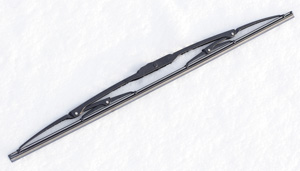Question: How often should wiper blades be replaced?
Answer: A standard recommendation is to replace wiper blades yearly (front and rear), or more often as needed depending on driving conditions and weather.
The life of the wiper blades depends on the materials from which they are made, how much exposure they get from the sun and outside temperatures (extreme heat or cold), how often they are used, and how much road splash and dirt ends up on the glass.

Road splash can be very abrasive when it contains hard particles of dirt, sand or gravel dust. As the blades lose their sharp edges, they can’t wipe as cleanly and may streak or smear. Sun exposure is also hard on the rubber because the ultraviolet rays cause the rubber to age and crack. This can lead to blade chatter and poor wiping performance.
Extremely cold weather makes the blades brittle and more prone to cracking, while extremely hot weather bakes out the elasticizers of the blades that help them remain soft and flexible.
Many blades are made of natural rubber because it provides one of the best wiping surfaces. But it doesn’t hold up to the environment as well as other synthetic materials. And, regardless of what the blades are made of, eventually they wear out and must be replaced.
Changing a set of wiper blades is fairly simple on most vehicles — once you’ve had some experience with the various blade mounting systems. There are a number of different mounting systems, and if you have never replaced a set of blades or haven’t encountered a particular type of mounting system before, removing the blades can be a confusing and intimidating experience. That’s why many motorists put off changing the blades even when they know the blades are bad and need to be replaced.
If they put it off long enough, the rubber will eventually tear away. And if the vehicle has metal blade holders, the holders may end up carving permanent scratches in the windshield.
Wiper blades should never be allowed to deteriorate to the point where they are literally falling apart. It’s dangerous because it limits wet weather visibility, and it may result in expensive damage to the glass. A windshield typically costs about $400 to $500 to replace, but a set of wiper blades may cost $10 to $30 a pair to replace. So, in the future, you’ll need to ask your customers which of these they would rather pay to replace.
Question: Some of the new “high-tech” wiper blades don’t have a traditional carrier assembly to hold and support the blade. How do they work?
Answer: Until recently, wipers have always had a flexible metal or plastic carrier to hold and support the rubber blade. The better quality wipers typically have more hinge and support points than economy blades, to distribute pressure more evenly for a cleaner wipe.
As the blade sweeps across the windshield, spring pressure exerted by the wiper arm pushes down on the blade assembly causing it to flex as needed so the rubber blade can follow the glass.
Traditional blades have a couple of limitations. One is that the carrier tends to ice up during cold weather, preventing the blade from flexing and wiping cleanly. The other is that the carrier is fairly bulky and creates wind resistance, which may cause the blade to lift away from a steeply sloped windshield at high speed.
To prevent wind lift, many wiper carriers have holes or slots to improve aerodynamics and reduce drag. Others also add small spoilers or wings that use the wind to push the blade down against the glass at highway speeds.
To prevent ice clogging, special “winter” blades are available that enclose the entire carrier assembly with a rubber cover.
The new high-tech wiper blades circumvent these design issues by using a different approach. Each blade incorporates an internal spring that places the blade under tension and allows it to bend as it follows the curvature of the glass. This allows the blade to hug the glass and maintain good contact for a clean wipe.
The lower profile also reduces drag and wind lift, and a smaller overall profile also improves visibility. Since there is no carrier to ice up, winter operation is also better.
